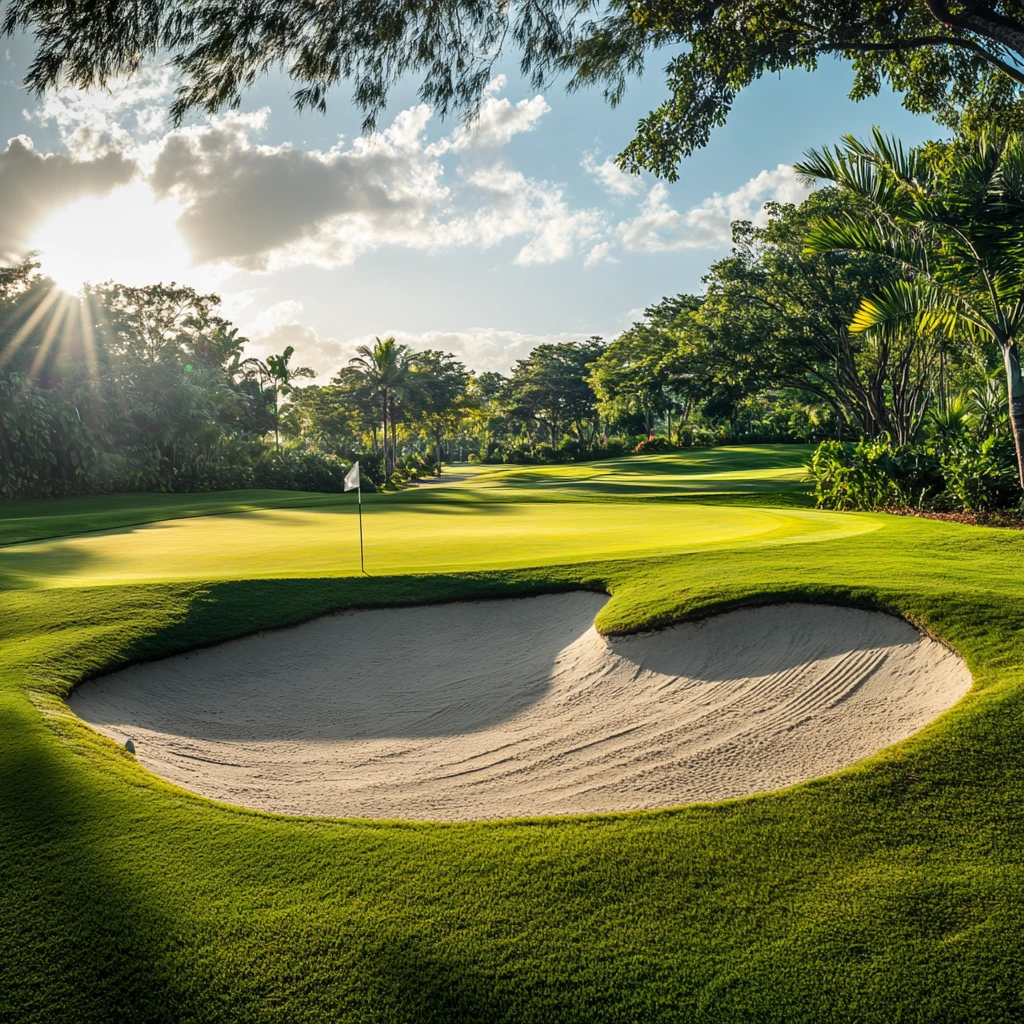Photosynthesis is like a marathon for your turf—without proper energy management, performance suffers, especially on demanding golf greens.
Just as a marathon runner needs to fuel their body for peak performance, your turf relies on a continuous energy supply to thrive. This energy source, essential for growth, repair, and resilience, comes from a complex biochemical process called photosynthesis in turf.
While this process might seem simple after proper understanding, it is intricate and directly impacts the health and appearance of your greens. By understanding the factors improving photosynthesis, you can optimise your turf’s performance and create a playing surface that is the envy of the course.
Whether decoding the challenges behind photosynthesis, common limitations in golf greens, or practical strategies to enhance photosynthetic output, this piece cuts to the chase with insights on maintaining turfgrass – without getting lost in the rough.
Challenges of Photosynthesis in Turf
Turfgrass is essential to recreational spaces, sports fields, and landscapes in Southeast Asia. However, it faces numerous challenges to its quality, sustainability, and health. These include a complex interplay between environmental factors, disease pressures, and increasing demands for these living surfaces. Some of them are mentioned below:
- 1. Reduced Light Exposure on Shaded Greens
Shaded areas on golf courses, typically under trees or other structures, are a significant challenge to golf greens’ photosynthesis. Reduced light exposure limits the amount of light energy available for the turfgrass to convert into energy. Consequently, shaded areas may exhibit slower growth, weaker root systems, and increased susceptibility to diseases and pests.
- 2. Heat Stress and Foot Traffic Stress
Extreme heat and heavy foot traffic can stress the turfgrass, reducing its photosynthetic capacity. At high temperatures, there will be excessive water loss and damage to the photosynthetic mechanism.
Similarly, constant foot traffic may cause physical damage to the leaf tissue, thus reducing the surface area available for photosynthesis in turf.
- 3. Inadequate Soil Conditions Leading to Poor Nutrient Absorption
Compaction of the soil or nutrient deficiency can be termed suboptimal conditions that hinder nutrient uptake in the turfgrass. Low nutrient absorption limits the availability of essential elements such as nitrogen, phosphorus, and potassium, which are critical for improving photosynthesis. In this case, the turfgrass may not produce enough energy to support growth and repair.
The Effects
Such golf greens’ photosynthesis stressors can have major impacts on turf health. Lowered photosynthetic activity slows growth, causes weaker roots, increases the turf’s susceptibility to diseases and pests, and lowers general turf quality. The result is higher maintenance costs, as more frequent mowing, fertilisation, and irrigation may be required to keep the turf healthy.
Consequences of Poor Photosynthesis
When turfgrass is unable to photosynthesize effectively, it cannot produce the energy it needs to grow. This sets off a chain reaction of effects that affect the health, appearance, and maintenance of the turf:
- Slower recovery from stress or wear: Photosynthesis is the source of energy that turfgrass uses to recover after a series of stressful events. Therefore, when golf greens’ photosynthesis is compromised, the rate of recovery is slowed significantly, with the turf remaining vulnerable to further wear and disease.
- Weak, patchy growth that affects playability and aesthetics: Less energy production results in weak and patchy grass growth patterns. The resulting thin, patchy turf detracts from the visual appeal of lawns, sports fields, and golf courses. In sports settings, it compromises the playing surface, affecting ball roll and increasing the risk of player injury.
- Higher maintenance costs: Turf managers often try to correct the symptoms of poor photosynthesis by over-applying fertilizers and water. This not only increases maintenance costs but can also create additional problems, such as nutrient runoff and increased susceptibility to disease.
The Solution: Turf Fit Technology for Photosynthetic Optimisation
Turf Fit triggers the plant’s defence system, safeguarding the critical components of photosynthesis. Additionally, It provides powerful biochemistries for injury repair, keeping photosynthesis running at its highest level.
This technology enables the golf grass to thrive in the most challenging conditions, ensuring improved performance and lower maintenance costs.
- 1. MicroBooster: Fueling Photosynthesis
MicroBooster provides a concentrated dose of essential micronutrients vital for photosynthesis in turf. These micronutrients, enriched with PowerSaccharides™, sea kelp, amino acids, vitamins, and key enzymes, play crucial roles in various enzymatic reactions that drive the photosynthetic process. Supplementing your turf with MicroBooster can enhance chlorophyll production, improve light absorption, and boost your overall turf energy supply.
- 2. The Core: Building a Strong Foundation
A strong root system is essential for efficient nutrient uptake and water absorption. The Core strengthens the root zone by providing a balanced blend of amino acids, highly available potassium, organic acids, and PowerSaccharides™.
These nutrients stimulate root growth, increase density, and enhance its ability to access essential nutrients from the soil. Investing in a robust root system can improve your turf’s resilience to stress and optimise its photosynthetic capacity.
- 3. Throttle: Sustained Energy Production
The Throttle controls the release of 33% slow-release triazine nitrogen, a key nutrient for golf greens’ photosynthesis. By regulating nitrogen availability, you can fine-tune your turf’s growth rate and optimise its energy production. Additionally, Throttle contains long-chain amino acids that enhance metabolic activity, allowing your turf to maintain healthy growth even under stressful conditions.
Benefits of Improved Photosynthesis with Turf Fit Technology
The main focus of Turf Fit technology is on finding solutions to turfgrass problems caused by limited sunlight, high-temperature stress, traffic stress, and poor nutrient uptake from inadequately prepared soil. Here are the list of benefits you can reap:
- 1. Improved Turf Performance
Since Turf Fit technology optimises photosynthesis, energy production is significantly improved. The healthy turf has a deeper colour and is greener. The turfgrass also gains the ability to recover faster from wear and stress like disease outbreaks, foot traffic, and mowing.
- 2. Resistance to Stress
Turf Fit technology gives turfgrass the power it needs to cope with environmental stress. Such products include MicroBooster and The Core, which strengthen the plant’s physiological process to withstand heat, drought, and heavy traffic. It improves nutrient uptake and enhances water retention, giving it a healthy appearance and functionality in the most adverse conditions.
- 3. Low Maintenance Cost
By optimising energy management, Turf Fit technology reduces the necessity for high inputs such as fertilisers and water. The enhanced photosynthetic efficiency enables the turf to use the nutrients better, decreasing the number of applications required.
Moreover, the improved stress tolerance of Turf Fit-treated turf also decreases the number of times it has to be treated against diseases and pests, further lowering maintenance costs.
- 4. Consistent Playability
A well-maintained golf course always provides consistent playability. Turf Fit technology promotes healthy, vigorous turf growth to maintain consistent playability throughout the year. The improved root system and enhanced nutrient uptake ensure that the turf remains vibrant and playable even during stress.
Practical Strategies to Boost Photosynthesis
Maximizing photosynthesis in turf requires a multi-faceted approach that combines product use with effective cultural practices. Here are some practical strategies:
- Address Shading Issues: Sunlight is the main driver of photosynthesis. Therefore, addressing issues with shading is important. This includes regular trimming of tree canopies and any other obstructions that keep sunlight from reaching the turf. Where possible, use shade-tolerant grass varieties that are well adapted to low-light conditions where complete sunlight exposure may not be possible.
- Aerate Regularly: Soil aeration is important for healthy root growth and function. The creation of small channels in the soil improves soil structure, which allows roots to gain access to vital resources such as water, air, and nutrients more efficiently.
- Apply MicroBooster, The Core, and Throttle: These products provide targeted support for golf greens’ photosynthesis and overall turf health. MicroBooster has nutrients ready for uptake during times of growth, providing an energy source for photosynthetic processes. The Core establishes a good root system and indirectly supports photosynthesis by taking up more nutrients and water. Throttle is designed for use during periods of high stress, helping the turf maintain energy production and photosynthetic efficiency even under adverse conditions.
- Monitor Soil Conditions: Soils need to be tested periodically to understand your turf’s specific requirements. The soil test can determine nutrient deficiencies, imbalances in pH, and other factors that limit photosynthesis.
- Water wisely: Irrigation should always ensure that there is enough moisture in the soil for improving photosynthesis. Watering during early morning hours reduces evaporation losses and maximizes turf absorption.
Real-World Applications
So far, Turf Fit products are showing real-world benefits across various turf applications. Here are some real-world examples:
Golf Greens: Golf course superintendents using Turf Fit products, especially the MicroBooster and The Core, have seen greens become healthier and perform much better. These products increase nutrient uptake, making the greens lusher and more vibrant. Importantly, they also help greens recover much faster after tournaments, with less disruption to play and consistent playability for golfers.
Sports Fields: High-traffic sports fields, particularly those in stadiums, experience constant wear and tear. Throttle makes a difference in these demanding environments by maintaining constant energy production and improving photosynthesis.
Landscapes and Parks: Land contractors managing public spaces reported that Turf Fit products, particularly MicroBooster and The Core- make maintenance much easier while offering beauty benefits to turf areas.
Witness the Transformative Power Of Optimized Photosynthesis!
Photosynthesis is more than just a natural process—it’s the key to unlocking your turf’s full potential. With Turf Fit technology and products like MicroBooster, The Core, and Throttle, you can take control of your turf’s energy supply and achieve healthier, more resilient grass.
Ready to maximise your turf’s performance? Visit The Core product page to explore these solutions and start your journey to stress-free turf management. Consultation options are also available to tailor strategies to your specific needs.


